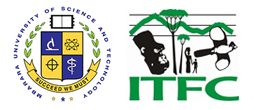Sarambwe Nature Reserve (SNR) located in the Democratic Republic of Congo (DRC) is contiguous with Bwindi Impenetrable National Park (BINP) partly forming a corridor for wildlife such as mountain gorillas. As a result a recent border reaffirmation by GVTC, the border reaffirmation process coincidentally caught up over 36 households as encroachers in SNR. We sort to assess the socioeconomic impacts of the encroachers on the ecological functions of the SNR through carrying out household surveys and forest surveys in the SNR. This was done within the SNR using household surveys, transects and plots respectively. A total of 40 households all located in the SNR were interviewed and of these, 23 were located in Democratic Republic of Congo (DRC) while 17 were located in Uganda.
Household survey results have shown that 80% of the respondents were born outside the SNR and these were between the ages of 20 to 40 years indication of the encroachment being a recent activity. The major source of income for respondents living in the SNR is subsistence farming (contributing to over 60%). All the interviewed respondents had no formal employment as a source of income. The subsistence farming was carried averagely in small acreage of land of up to 5 acres per household.
Indigenous tree species’ stem density was significantly different between forested and the “cleared forested” areas of SNR. Tree species stem density were highest in the forested areas than in the cleared forested areas. Tree species with high stem densities included the Psychotria mahonii, Myrianthus holstii and Milletia dura while those with low stem densities were in the cleared forested areas and included the Carapa procera, Leplaea mayombesis and Shirakiopsis ellaptca. Furthermore, the size class distribution of the different tree species was significantly different between the forested and the “cleared forested” areas. Large sized tree individuals (adults) were more abundant in the forested areas than in than in “cleared forestd” areas and vice versa for small sized individuals. Tree species diversity was highest in the forested areas than in the cleared forested areas. Four types of large mammals were encountered (either directly or by signs) in the study area. These were the Black and White Colobus monkeys, Black Fronted Duikers, Bush pigs and the Red tailed monkeys. Eighty seven (87) species of birds were recorded in both forested and “cleared forested” areas of SNR recorded and of these, 15 were Albertine Rift Endemics.
In conclusion, past and present anthropogenic perturbations in Bwindi and SNR have largely played a role in the distributions of tree species and fauna in the forest. Almost all the recorded tree species in SNR are majorly secondary forest types that prefer disturbance and more light conditions since they responded by increased regeneration in highly disturbed areas. We therefore recommend the eviction of the encroachers from SNR and the active management by planting of indigenous trees and removal of exotics from the nature reserve to restore the ecological integrity of SNR.
Report File
- Document
